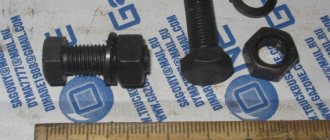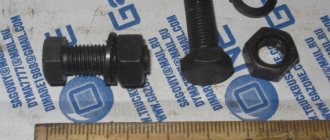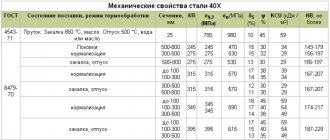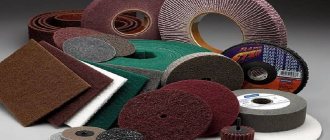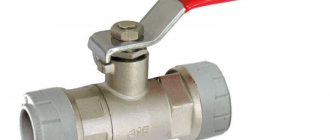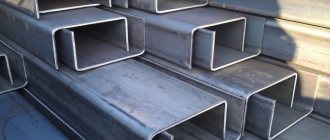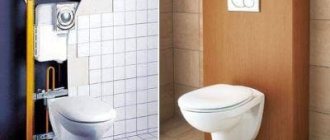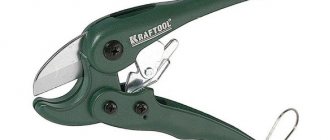History of the creation of the part
In the 19th century, mechanical engineering began to develop rapidly, which led to the need to create reliable and durable types of connections. Threaded structures were not of high quality; other varieties did not bring the desired effect due to the sensitivity of the load. Under the influence of vibration and vibrations, connections lose strength and tightness. With the advent of the spring washer, the situation has improved significantly. The part is durable and reliable, which is maintained even under various loads.
The design is a simple element, keeping its cost low without sacrificing reliability. Washer production is regulated by the standards established in GOST 6402-70. The main features of the grower are the following:
- is a regular part of a spring;
- involuntary unscrewing is eliminated due to the direction opposite to the nut's movement;
- With the help of the edge, the structure rotates and then digs into the surface of the workpiece.
The product marking indicates the characteristics of the part, including the material of manufacture and diameter indicators. For production, certain grades of metal are used that are capable of providing high performance properties.
GOST 6402-70 Spring washers
| SPRING WASHERS Technical specifications Lock washers. Specifications | GOST 6402-70* (ST SEV 2665-80) Replaces GOST 6402-61 |
By Decree of the Committee of Standards, Measures and Measuring Instruments under the Council of Ministers of the USSR dated April 17, 1970 No. 532, the introduction date was set from 01/01/72
This standard applies to spring washers for bolts, screws and studs with thread diameters from 2 to 48 mm.
Spring washers should be made of four types:
- N - normal with a square cross section;
- T - heavy with a square cross section;
- OT - extra heavy with a square cross section;
- L - lungs with a rectangular cross section.
The design and main dimensions of the washers must correspond to those indicated in the drawing. 1 and in the table.
Crap. 1
| Nominal thread diameter of bolt, screw, stud | d | Types of washers | k, (for washers type L and N), no more | ||||||||||
| Light washers (L) | Normal washers (N) | Heavy washers (T) | Extra heavy washers (OT) | ||||||||||
| b | s | b=s | b=s | b=s | |||||||||
| Nom. | Prev. off | Nom. | Prev. off | Nom. | Prev. off | Nom. | Prev. off | Nom. | Prev. off | Nom. | Prev. off | ||
| 2 | 2,1 | +0,25 | 0,8 | ±0,08 | 0,5 | ±0,07 | 0,5 | ±0,07 | 0,6 | ±0,07 | — | — | — |
| 2,5 | 2,6 | 0,8 | 0,6 | 0,6 | 0,8 | ±0,08 | |||||||
| 3 | 3,1 | +0,30 | 1,0 | ±0,125 | (0,6) | 0,8 | ±0,08 | 1,0 | ±0,125 | ||||
| 0,8 | ±0,08 | ||||||||||||
| 3,5 | 3,6 | 1,0 | 0,8 | 1,0 | ±0,125 | — | 0,15 | ||||||
| 4 | 4,1 | 1,2 | 0,8 | 1,0 | 1,4 | ||||||||
| (1,4) | (1,0) | ±0,125 | (1,2) | ||||||||||
| 5 | 5,1 | 1,2 | 1,0 | 1,2 | 1,6 | ||||||||
| (1,6) | (1,2) | (1,4) | |||||||||||
| 6 | 6,1 | +0,58 | 1,6 | 1,2 | 1,4 | 2,0 | 0,2 | ||||||
| (2,0) | (1,4) | (1,6) | |||||||||||
| 7 | 7,2 | 2,0 | 1,6 | 2,0 | — | ||||||||
| 8 | 8,2 | 2,0 | 1,6 | 2,0 | 2,5 | 0,3 | |||||||
| (2,5) | |||||||||||||
| 10 | 10,2 | +0,70 | 2,5 | 2,0 | 2,5 | 3,0 | 3,5 | ±0,24 | |||||
| (3,0) | |||||||||||||
| 12 | 12,2 | 3,5 | ±0,15 | 2,5 | 3,0 | 3,5 | ±0,24 | 4,0 | 0,4 | ||||
| 14 | 14,2 | 4,0 | 3,0 | 3,2 | ±0,15 | 4,0 | ±0,24 | 4,5 | ±0,24 | 0,4 | |||
| (3,5) | |||||||||||||
| 16 | 16,3 | 4,5 | 3,2 | ±0,15 | 3,5 | 4,5 | 5,0 | ||||||
| (4,0) | |||||||||||||
| 18 | 18,3 | +0,84 | 5,0 | 3,5 | 4,0 | 5,0 | 5,5 | ||||||
| (4,5) | |||||||||||||
| 20 | 20,5 | 5,5 | (4,0) | 4,5 | 5,5 | 6,0 | |||||||
| (5,0) | |||||||||||||
| 22 | 22,5 | 6,0 | 4,5 | 5,0 | 6,0 | 7,0 | ±0,29 | ||||||
| (5,5) | |||||||||||||
| 24 | 24,5 | 6,5 | ±0,18 | 4,8 | 5,5 | 7,0 | ±0,29 | 8,0 | ±0,29 | 0,5 | |||
| (7,0) | (5,0) | (6,0) | |||||||||||
| 27 | 27,5 | 7,0 | 5,5 | 6,0 | 8,0 | 9,0 | |||||||
| (8,0) | (7,0) | ±0,18 | |||||||||||
| 30 | 30,5 | +1,00 | 8,0 | 6,0 | 6,5 | 9,0 | 10,0 | 0,8 | |||||
| (9,0) | (8,0) | ||||||||||||
| 33 | 33,5 | 10,0 | 6,0 | 7,0 | — | — | |||||||
| 36 | 36,5 | 10,0 | 6,0 | 8,0 | 10,0 | 12,0 | ±0,35 | ||||||
| (9,0) | |||||||||||||
| 39 | 39,5 | 10,0 | 6,0 | 8,5 | — | — | — | ||||||
| 42 | 42,5 | 12,0 | ±0,215 | 7,0 | ±0,18 | 9,0 | 12,0 | ±0,35 | |||||
| (10,0) | |||||||||||||
| 45 | 45,5 | 12,0 | 7,0 | 9,5 | — | — | |||||||
| 48 | 48,5 | 12,0 | 7,0 | 10,0 | |||||||||
| (12,0) | ±0,215 | ||||||||||||
Notes: 1. It is allowed to increase size s within 10% of the nominal size. 2. Washers with dimensions enclosed in brackets may be used until 01/01/85 and the letter “y” must be indicated in their designation.
Examples of symbols for a spring washer of version 1 for a bolt, screw, stud with a diameter of 8 mm: normal, made of steel grade 3X13 without coating: Washer 8 3X13 GOST 6402-70
light steel grade 65G with cadmium coating 9 microns thick, chromated: Washer 8L 65G 029 GOST 6402-70
the same, version 2, with dimensions enclosed in brackets: Washer 2U 8L 65G 029 GOST 6402-70
Spring washers must be made of wire in accordance with GOST 11850-72 or according to other regulatory and technical documentation from steel grades 65G, 70 and 3X13. It is allowed to manufacture spring washers from bronze grade BrKMts3-1 according to GOST 18175-78 or other non-ferrous alloys.
Testing the spring properties of washers is carried out in the following order:
Crap. 2 Damn. 3 Damn. 4
WEIGHT OF STEEL WASHERS AND THEIR SPRING PROPERTIES
| Nominal thread diameter of bolt, screw, stud | Theoretical weight 1000 pcs. steel washers, kg | Calculated elastic force of washers made of steel 65G, N | ||||||
| Types of washers | Types of washers | |||||||
| Lungs (L) | Normal (N) | Heavy (T) | Extra heavy (OT) | Lungs (L) | Normal (N) | Heavy (T) | Extra heavy (OT) | |
| 2 | 0,030 | 0,017 | 0,025 | — | 7,8 | 11,8 | 26,5 | — |
| 2,5 | 0,042 | 0,030 | 0,056 | 14,7 | 16,7 | 57,8 | ||
| 3 | 0,084 (0,061) | 0,064 | 0.105uk-table uk-table-hover uk-table-striped uk-table-condensed | 35,3 (8,8) | 38,2 | 101 | ||
| 3,5 | 0,094 | 0,117 | — | 21,6 | 71,5 | — | ||
| 4 | 0,129 (0,190) | 0,129 (0,189) | 0,273 | 14,7 (50,0) | 52,9 (136) | 230 | ||
| 5 | 0,191 (0,318) | 0,228 (0,315) | 0,432 | 28,4 (67,6) | 71,5 (158) | 252 | ||
| 6 | 0,378 (0,560) | 0,376 (0,487) | 0,827 | 36,3 (81,3) | 88,2 (184) | 418 | ||
| 7 | 0,749 | 0,936 | — | 92,1 | 289 | — | ||
| 8 | 0,827 (1,046) | 1,034 | 1,678 | 71,5 (69,6) | 214 | 583 | ||
| 10 | 1,608 (1,940) | 2,010 | 2,984 | 4,212 | 114 (113) | 339 | 770 | 1490 |
| 12 | 3,462 | 3,450 | 4,816 | 6,488 | 187 | 499 | 1000 | 1774 |
| 14 | 5,487 | 4,480 (5,355) | 7,316 | 9,509 | 295 | 463 (756) | 1235 | 2058 |
| 16 | 7,507 | 6,084 (8,022) | 10,56 | 13,34 | 283 | 495 (990) | 1509 | 2372 |
| 18 | 10,23 | 8,960 (11,40) | 14,62 | 18,06 | 305 | 673 (1254) | 1803 | 2734 |
| 20 | 14,33 | 12,69 (15,75) | 19,70 | 23,89 | 434 | 866 (1539) | 2107 | 3077 |
| 22 | 19,25 | 17,21 (20,92) | 25,66 | 36,14 | 597 | 1107 (1862) | 2479 | 4841 |
| 24 | 24,16 (27,21) | 22,68 (27,12) | 38,55 | 51,93 | 642 (818) | 1382 (2225) | 3989 | 7085 |
| 27 | 33,14 (38,15) | 30,10 (41,76) | 56,67 | 73,71 | 928 (911) | 1539 (3293) | 5459 | 9055 |
| 30 | 46,14 (52,64) | 39,05 (60,87) | 79,80 | 101,1 | 1029 (1009) | 1695 (4606) | 7115 | 11192 |
| 33 | 65,07 | 49,52 | — | — | 692 | 1882 | — | 16317 |
| 36 | 69,51 | 70,99 (91,03) | 115,9 | 173,9 | 566 | 2773 (4998) | 7428 | |
| 39 | 73,9 | 86,37 | — | — | 469 | 2999 | — | — |
| 42 | 113,9 | 103,8 (129,7) | 195,2 | 756 | 3244 (5488) | 11535 | ||
| 45 | 120,1 | 123,5 | — | 643 | 3489 | — | ||
| 48 | 126,3 | 145,4 (215,2) | 554 | 3753 (8879) | ||||
Buy GOST 6402-70 Spring washers wholesale and retail in our store in Tolyatti at the address: st. Obvodnoe highway, 3G., as well as with delivery to the cities: Samara, Ulyanovsk, Dimitrovgrad.
Types of Grover Washers
Most often, a spring washer is used to create bolted connections. If it is necessary to increase the contact area, the design is supplemented with the usual version. This is a guarantee of durability. When considering a hardware drawing, two options can be distinguished:
- Simple. The spring washer can have different diameters and coil thicknesses. The design is characterized by the obligatory deflection of the coils at a certain angle relative to the central axis.
- Difficult. Suitable for highly loaded connections, including shock and vibration.
Today, galvanized locking washer DIN 127 M8 is in wide demand. The part is superior to similar options due to special treatment designed to protect the surface from various external influences. Also common is the DIN 7980 fastener, which also has its own distinctive features.
Hardware is produced with right-hand winding; in some cases, the use of designs with left-hand winding is allowed.
Advantages and Disadvantages of Grover Spring Washer
The main advantage of the design is its low cost and simple production technology. Among the disadvantages of the grower washer, several stand out:
- lack of structural strength due to high dynamic loads during operation;
- during tightening, the washer can turn into a simple plate that loses its fixing properties;
- It is prohibited to reuse the hardware after dismantling, since the element is significantly deformed.
The spring washer is suitable for organizing simple and temporary connections. If it is possible to replace the structure with a more reliable one, it is recommended to dismantle it and install other fasteners.
Replacing the spring washer
To securely fix the nut, various designs are used, which successfully replace the grower. Some of the most common hardware options include:
- Self-locking nuts. The fastener features a distinctive plastic insert that is used to reduce vibration and shock loads. This prevents spontaneous unwinding. More complex technologies are used to produce hardware, which affects its cost.
- Disc type washer. It is excellent for replacing a standard spring washer, has a low price and increased reliability.
- Crown nut. Suitable for various situations where it is necessary to create a hole for installing a cotter pin. The connection belongs to the category of stepped ones, and is reliable.
- Gear type flange. The hardware is characterized by notches designed for tight fusion with the nut. This guarantees the strength of the connection and resistance to spontaneous unscrewing.
- Lock washer. It is distinguished by many teeth used for tight fixation.
- Plates with antennae. This type of connection is different from the usual ones. Reliability is ensured due to the fact that one of the tendrils is installed in the part; the remaining ones need to go around the turns. There are several types of fasteners, so choose the appropriate option for each case.
- Wire locks. Hardware is also characterized by low price and ease of production.
When choosing, be guided by the conditions of use, technical characteristics of the product and other factors that may affect the strength of the connection.
Manufacturing and materials for the grower
The production of such spring washers occurs strictly in accordance with GOST 6402−70. Several materials are used to make parts:
- Steel.
- Bronze.
- Non-ferrous alloys.
Typically, the hardness of metal products is in the range of 40–48 HRC. If St 70 is used, this figure can be increased to 50 HRC. The hardness of a bronze grower should be above 90 HRC. Parts are considered defective if the following are found on the surface:
- Burrs.
- Scale.
- Cracks.
- Corrosion.
The current standard allows small defects located on the cut, traces of scale that cannot be separated. They do not have any effect on the dimensions of the part, as well as its strength characteristics.
The product will not be rejected if a slight trapezoidal cross-section is detected. In this case, the height of the part must be within acceptable limits. Finished products must be subjected to control tests. The Grover is squeezed several times until the diverging ends form one flat surface. This state is maintained for 24 hours. The height of the streaks should not exceed 1.65 times the thickness of the washer. Chips and cracks are not allowed.
Several types of washers are produced in production, with the dimensions specified in GOST. They are divided into groups:
- Ordinary.
- Heavy.
- Particularly heavy.
- Lungs.
The first three products have a square cross section. In the lungs it looks like a rectangle.
The main material for the production of growers is spring steel. The finished part undergoes heat treatment , giving it high strength and resistance to various external influences. Heat treatment also reduces the fragility of the part. To protect parts from corrosion, they are galvanized.
The washer is dipped into an electrolyte, where small particles of zinc are deposited on its surface. As a result, the part is coated with a zinc layer, the thickness of which reaches 25 microns.
The product comes in several shades:
- White.
- Blue.
- Rainbow.
Yellow chrome plating is also used to create an anti-corrosion layer. The outer surface of the washer is saturated with chromium. It protects the product from increased wear and also increases the hardness of the product.
Types of spring washers
The production of grower is regulated by GOST 6402-70 standard. The standards establish requirements for the material of manufacture, standard sizes and other technical characteristics of the product. During the manufacturing process, the manufacturer adheres to the following rules:
- the product can be made of bronze, various grades of steel and some non-ferrous alloys;
- hardness indicators vary from 40 to 48 HRC, for bronze structures the value exceeds 90 HRC;
- the production technology is chosen by the manufacturer, and it is important to ensure the absence of defects, burrs, cracks and other types of defects in the product;
- sometimes minor defects are allowed that do not affect the strength of the connection;
- At the final stage of production, the product is subjected to various tests.
Most often, high-quality washers are made from spring steel. The material provides maximum strength and resistance to external influences. Heat treatment increases the hardness of the hardware.
Spring washer modifications
GOST 6402-70 classifies four types of products. Three of them have a square cross-section (b=s): N - normal, T - heavy, OT - especially heavy. The letter H is not indicated in the symbol.
Type L spring washers are lightweight with a rectangular cross-section.
For the same nominal thread diameter size, the cross-sectional area increases, which affects the weight of the product as a whole. The table below shows the theoretical mass values and spring properties.
The dimensions of the washer are directly related to the diameters of the mating bolts, screws and studs. Russian standard 6402 applies to hardware with a thread diameter from 2 mm to 48 mm. Extra heavy OT washers are manufactured only for the thread diameter range from 10 mm to 36 mm.
Installing the Grover Washer
The process of installing hardware differs slightly from the standard installation of other similar fasteners. Among the main features are the following:
- the structure is placed between the nut and the part being connected;
- Grover can be used in conjunction with conventional nuts.
The spring nut is in demand due to its ease of use. Therefore, it is found in various fields as temporary or permanent fasteners. It is better to replace the part with a more expensive one over time for several reasons:
- the grower is susceptible to mechanical damage;
- cannot be reused due to deformation;
- technical properties decrease over time.
It is not recommended to use a locking washer for critical connections.
